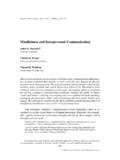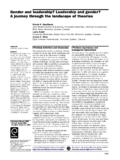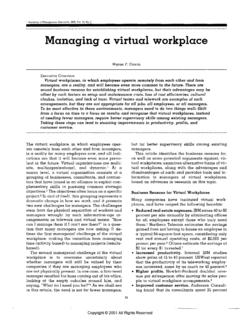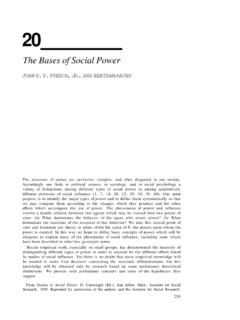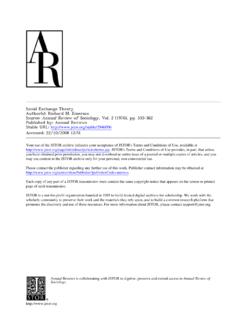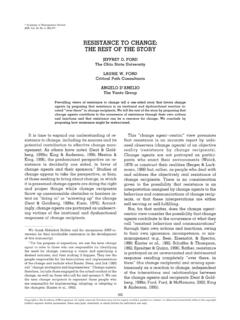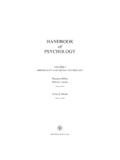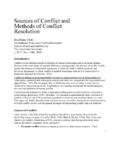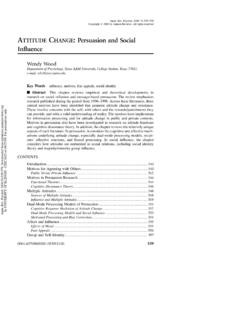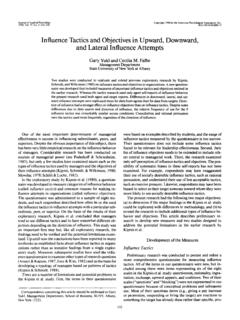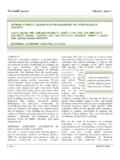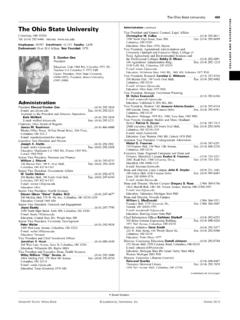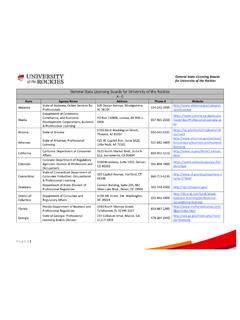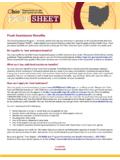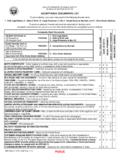Transcription of The Role of Transportation in the Persuasiveness of …
1 Journal of Personality and Social Psychology Copyright 2000 by the American Psychological Association. Inc. 2000, Vol. 79, No. 5, 701-721 0022-3514/00/$ DOI: The Role of Transportation in the Persuasiveness of Public Narratives Melanie C. Green and Timothy C. Brock Ohio State University Transportation was proposed as a mechanism whereby narratives can affect beliefs. Defined as absorp- tion into a story, Transportation entails imagery, affect, and attentional focus. A Transportation scale was developed and validated. Experiment 1 (N = 97) demonstrated that extent of Transportation augmented story-consistent beliefs and favorable evaluations of protagonists.
2 Experiment 2 (N = 69) showed that highly transported readers found fewer false notes in a story than less-transported readers. Experiments 3 (N = 274) and 4 (N = 258) again replicated the effects of Transportation on beliefs and evaluations; in the latter study, Transportation was directly manipulated by using processing instructions. Reduced Transportation led to reduced story-consistent beliefs and evaluations. The studies alSO showed that Transportation and corresponding beliefs were generally unaffected by labeling a story as fact or as fiction. The scientific study of persuasion has reflected an unfortunate displacement of poetics by rhetoric.
3 Advocacy messages rather than narrative messages have been the subject matter of persuasion scholars for the past half-century ( , Hovland, Lumsdaine, & Sheffield, 1949; Shavitt & Brock, 1994). This striking imbalance in scientific attention has been sustained even though in the expe- rience of people everywhere, public narrative predominates over public advocacy: Novels, films, soap operas, music lyrics, stories in newspapers, magazines, TV, and radio command far more waking attention than do advertisements, sermons, editorials, bill- boards, and so forth. The power of narratives to change beliefs has never been doubted and has always been feared.
4 Consequently, censorship has been ubiquitous for centuries: In the United States, . one out of three high school students experiences banning of books (Davis, 1979). A film version of Lolita, the "fourth best English- language novel published this century" (Modem Library Editorial Board, 1998), was withheld for 2 years from American audiences. Yet, the persuasive impact of public narratives has been virtually ignored by empirical researchers; indeed, Persuasiveness of narra- fives is a nonexistent reference item in a recent authoritative, comprehensive graduate-level textbook with 2,800 references (The Psychology of Attitudes, Eagly & Chaiken, 1993).
5 In an attempt to redress the rhetoric-poetics imbalance, we explored the persuasive impact of a narrative in terms of the extent to which recipients Melanie C. Green and Timothy C. Brock, Department of Psychology, Ohio State University. This article was based in part on portions of a master's thesis by Melanie C. Green. We thank the members of the thesis committee, Richard Petty and Philip Tetlock, for their insightful suggestions regarding the research. We also thank Lee Fabrigar for statistical assistance and Richard Gerrig for his thoughtful comments on various aspects of the research.
6 Darcy Reich, Christian Wheeler, Sharon Shavitt, and Lee Fabrigar provided insightful and helpful comments on earlier drafts of this article. Correspondence concerning this article should be addressed to Melanie C. Green, who is now at the Department of Psychology, University of Pennsylvania, Philadelphia, Pennsylvania 19104, or to Timothy C. Brock, Department of Psychology, Ohio State University, Columbus, Ohio 43210. Electronic mail may be sent to or @ were "transported" into the world of the narrative and became involved with its protagonists. In essence, a narrative account requires a story that raises unanswered questions, presents unresolved conflicts, or depicts not yet completed activity; characters may encounter and then resolve a crisis or crises.
7 A story line, with a beginning, middle, and end, is identifiable. In Bruner's (1986) words, "[Narrative] deals in human or human-like intention and action and the vicissitudes and consequences that mark their course. It strives to put its timeless miracles into the particulars of experience and to locate the expe- rience in time and place" (p. 13). Are the processes that underlie narrative persuasion different from those that mediate the impact of nonnarrative or nonfiction communications on beliefs? When a narrative is explicitly labeled as fiction, under what conditions can it change beliefs about issues entailed in the story?
8 Can a narrative affect broader attitudes, ones only implied by the focal text? Transportation Theory To the extent that individuals are absorbed into a story or transported into a narrative word, they may show effects of the story on their real-world beliefs. We conceptualized Transportation into a narrative world as a distinct mental process, an integrative melding of attention, imagery, and feelings. Our conceptualization of Transportation was based on Gerrig's (1993) description: Someone ("the traveler") is transported, by some means of transpor- tation, as a result of performing certain actions.
9 The traveler goes some distance from his or her world of origin, which makes some aspects of the world of origin inaccessible. The traveler returns to the world of origin, somewhat changed by the journey. (pp. 10-11) Gerrig used the literal experience of traveling to explain the processes that occur when a reader encounters a text. The feeling of being lost in a story (Nell, 1988) is familiar to many people; one of our theoretical alms was to specify components and conse- quences of this experience. Following Gerrig, we conceived of Transportation as a conver- gent process, where all mental systems and capacities become focused on events occurring in the narrative.
10 The first consequence 701 702 GREEN AND BROCK of Transportation is that parts of the world of origin become inaccessible. In other words, the reader loses access to some real-world facts in favor of accepting the narrative world that the author has created. This loss of access may occur on a physical level--a transported reader may not notice others entering the room, for example--or, more importantly, on a psychological level, a subjective distancing from reality. While the person is immersed in the story, he or she may be less aware of real-world facts that contradict assertions made in the narrative.
